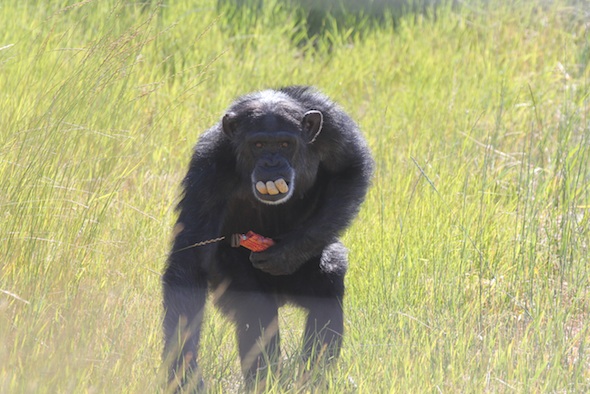As you may have heard last week, thanks to all the public support for the Great Ape Protection and Cost Savings Act, the Senate Environment and Public Works Committee favorably approved the bill (S. 810). This is a huge step forward, but we aren’t done yet! Though GAPCSA has been approved by the committee, it has not passed in the Senate—yet. With your support, we can move even farther ahead in helping release chimpanzees from invasive biomedical research. Visit Project Release & Restitution’s website to find details on how to keep the ball rolling.
Archives for July 2012
The two sides of Annie
Pea tendrils
About a year ago, volunteer Connie brought over some pea plants for the chimps. They were a huge hit, so this summer she brought some more from her garden! Today they had a big pea shoot and tendril forage.
Jamie and Negra with the tendrils:
Jamie:
Jamie was taking the peas and spitting them out, and eating only the pods plus the shoots and tendrils. You can see the pea “rejects” on the floor in the background of this picture of Negra:
Negra looking in a tendril-filled boot:
Chimps have big mouth pouches and they sometimes munch fibrous foods all together to get out as much flavor as possible. We call this a “wadge.” Here’s Annie with a pea plant wadge:
Thanks again, Connie!
Lovable Dora
Dora is not loved just by Foxie. Here’s Jody with a stuffed Dora:
Foxie and Burrito play
Luau!
Yesterday, we threw the chimps a Luau! Volunteer Steph and I have been planning it for a couple of months now and she went shopping and got so much cute stuff! There were 5 adorable pinatas (including a mermaid, a dolphin, a tiki man, a toucan, and a sun), a giant palm tree, fishing nets, leis, and tons of festive cups for tropical drinks. She went waaay over the top with this party– and it was perfect!
Over the last couple of months, I’ve been collecting all the Luau-like troll dolls and Doras too

Thankfully, the chimps were just as enriched as we were!
Negra and Annie focused heavily on the peanuts in the pinatas:

Once the tropical juice was all gone, the Luau spilled out onto Young’s Hill. Jamie was so excited about the pineapple:

Foxie explored the hill and collected chow with her new Dora

Steph also brought banana blossoms, which Jody thoroughly enjoyed but Annie found one on the hill. She looked pretty proud of herself!

Thanks so much for bringing Hawaii to the chimps, Steph!
Take Action Tuesday Post #1
For the past few months, I’ve been working on broadening our advocacy program, Primate Patrol, which currently focuses on the use of chimpanzees in entertainment. Our goal is to be a good resource for information about all chimpanzee issues, and to provide ways for you to take action and help. Stay tuned in the coming months for lots of great new stuff!
If you aren’t already subscribed to our Take Action newsletter list, please sign up today! Help us spread the word by getting your friends to sign up, too!
Now that I’ve introduced our plans for expansion, I’ll start what will be a regular blog entry: Take Action Tuesday. Every week, I will post advocacy related news and ways you can help.
This week’s topic is about roadside zoos and pseudo-sanctuaries, often a dumping ground for ex-pet or ex-entertainment chimps. This video on Facebook shows two chimps, Rocky and Kelby, who were both used in entertainment. Kelby was in movies such as Babe, Pig in the City and Buddy. Rocky was once owned by former chimp trainer Sid Yost. As you can see in the video, the cages are small and dirty.
Rocky and Kelby have lived in a number of different facilities. These two are currently living at Suncoast Primate Sanctuary (AKA Chimp Farm) – a substandard roadside zoo that puts its residents on display.
Suncoast Primate Sanctuary is also home to at least one infant chimpanzee. Many roadside zoos breed animals and advertise the babies as attractions. Facilities that breed their animals are perpetuating the sad cycle of captivity. The Institute of Greatly Endangered and Rare Species (T.I.G.E.R.S.) is another pseudo-sanctuary, home to the orangutan Suryia (who was used in a commercial). The Big Cat Habitat and Gulf Coast Sanctuary, run by the last remaining circus trainers (the Rosaire-Zoppes) is home to Ricky the chimpanzee (featured on a book cover). All of these facilities breed their exotic animals and continue to exploit them for entertainment purposes. Reputable sanctuaries do not intentionally breed—producing babies whose fate is a lifetime of confinement is simply wrong.
What can you do to help chimps in roadside zoos? Speak up for these exploited animals, and spread the word. If a friend sends you a “cute†picture of a baby chimpanzee holding a tiger cub, take a moment to educate them about the truth behind pseudo-sanctuaries that promote those types of photos (See below for a sample message to send to your friends). Do your research before donating to any sanctuary and support rescue organizations that are committed to providing quality lifetime care.
Sample response to “cute†pictures from a pseudo-sanctuary:
Sadly, this picture is not cute and cuddly as it may appear. Portraying these exotic animals as cute and cuddly attractions seriously misinforms people about the true nature of these beings and perpetuates the pet and entertainment industries. Simply put, chimpanzees are not meant for our world and should not be in captivity. Infant chimpanzees should be with their chimpanzee mothers — not tiger cubs, dogs, or humans. Unfortunately, the facilities where these pictures originate are breeding exotic animals, which leads to a lifetime of unwarranted imprisonment for those animals. No respectable sanctuary would intentionally breed, nor would they put their animals on display or exploit them for entertainment purposes.





























